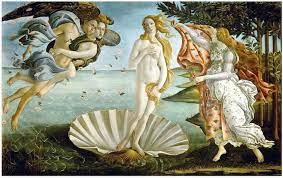Romantic Era Blog
A Comparative Analysis of Romanticism and Realism: Intentions and Personal Preferences in Art
From the late 18th
through the middle of the 19th century, the Romantic Era saw a tremendous shift
in philosophy, literature, and art. This was the era when the Romantic and
Realist movements in art first appeared. Although both movements have their
beginnings in the same time period, there are significant differences between
their goals, methods, and subjects. By analyzing their goals and my own
preferences for the two major Romantic era styles, this essay seeks to compare
them. I will choose two pieces from each style, created by two separate
artists, and analyze my aesthetic response to each style by looking at its
visual components and talking about my feelings and presentation preferences.
Romanticism: Intentions and Selected Works
The development of
romanticism was a response to the materialism and scientific outlook of the
Enlightenment. Romantic artists aimed to communicate the strength of the
individual's imagination and subjective experience. They used dramatic and
imaginative scenes from nature, history, or literature to communicate strong emotions
like terror, amazement, and love.
Work 1: "Wanderer Above the Sea of
Fog" by Caspar David Friedrich
The attention to the
fantastic and the beauty of nature throughout the Romantic era is perfectly
illustrated in this artwork. The traveler looks out over a huge, fogged-over
countryside from atop a rocky outcrop. With the traveler facing away from
the viewer, the composition of the painting encourages us to participate in the
scene's emotional impact. The observer is filled with amazement and awe at the
magnificence of the landscape and the dramatic interaction of light and shadow.
Work 2: "Liberty Leading the
People" by Eugène Delacroix
The 1830 French
Revolution provided the framework for this painting, which effectively
illustrates the Romantic era's emphasis on passion and individualism. The
various group of people that the symbolic figure of Liberty is leading is a
representation of the revolutionaries' passion and harmony. The scene's impact
on the viewer's emotions is amplified by the usage of vivid colors, a dynamic
layout, and dramatic lighting.
Realism: Intentions and Selected Works
Realism, as opposed to
Romanticism, sought to capture the world as it actually was, without excess or
romanticism. Realist painters emphasized commonplace themes, frequently
illustrating the lives of common people and the challenges in the global of the
day. To give their paintings a sense of authenticity and realism, they applied
exact, detailed techniques.
Work 3: "The Gleaners" by
Jean-François Millet
This picture serves as a
great illustration of Realism's attention on the regular lives of people. Three
rural ladies are shown in the picture gathering leftover grain from a harvested
field. A sense of realism and empathy for the individuals is created by
Millet's careful consideration of detail and the modest color scheme,
emphasizing the hard realities of village life.
Work 4: "A Bar at the
Folies-Bergère" by Édouard Manet
Manet corresponds to the
lively atmosphere of a Parisian bar in this work of art. Despite the busy
scene, the barmaid's distant stare and the reflection in the mirror give the
impression of distance and loneliness. Realist attention to accuracy and
truthfulness is demonstrated by the detailed representation of the numerous
items in the bar and the open presentation of the bartender.
Aesthetic Reaction and Personal
Preferences
I'm more drawn to the
Romantic style after looking at the Realist and Romantic art components in the
chosen pieces. Romanticism's dramatic lighting, vibrant colors, and dynamic
compositions generate strong feelings in me and spark my imagination. I
personally connect with the emphasis on the magnificent and the unique
experience seen in Romantic works like Friedrich's "Wanderer Over the Sea
of Fog" and Delacroix's "Liberty Leading the People."
While I enjoy the
realistic detail and representation of everyday life in realist paintings like
Manet's "A Bar at the Folies-Bergère" and Millet's "The
Gleaners," I think that the emotional effect and creative power of
Romantic paintings are more in line with my preferences.
In summary, romantic
artists emphasize the individual's subjective experience and the power of
imagination, whereas realist artists strive to capture reality as it is,
without romanticization or dramatization. I discovered that I was more drawn to
the Romantic style because of its emotional impact and creative potential after
looking at a few representative pieces from each aesthetic and analyzing my
aesthetic reaction. Yet, as both Romanticism and Realism provide insightful
perspectives on humanity and the society we live in, this preference is
highly personal and should not be interpreted as a judgment on the relative
importance of either.




Hi Carli, I really enjoyed your blog! Of the two styles of art you have selected, I really liked the realism style of art, I think that capturing how something was compared to how we think we see it is more important. I think realism has more historical significance as well, being able to make an unfiltered image with a bare perspective can prove a more realistic portrayal of what is happening in the image. I also agree in "Wanderer Above the Sea of Fog" that the fog strengthens the scenes emotional impact deeply. The dramatic intention ties the whole image together. I also completely agree that both Romantic and Realism art style provide insightful perspectives with social community and humanity. I think that artists from the Realism art style definitely create more emotionally charged paintings which I completely see why they did that, we get to see through Friedrich and Delacroix's eyes of how they experienced that view. I think Millet and Manet do a great job of portraying how something is compared to how something is perceived, which I really appreciate. Great job Carli!
ReplyDelete